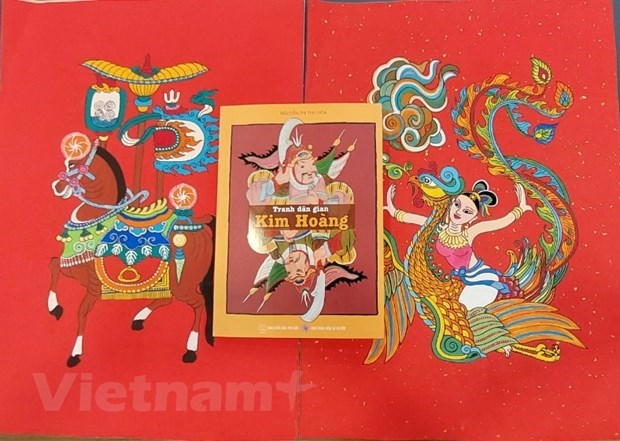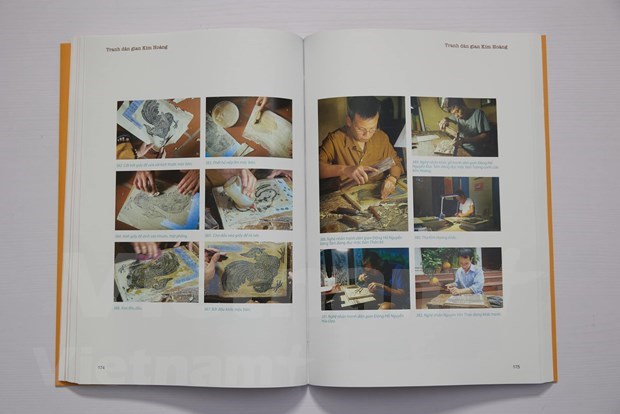Collector launches new book on Kim Hoang folk painting
 Kim Hoang folk painting (Photo: VietnamPlus)
Kim Hoang folk painting (Photo: VietnamPlus)Hanoi (VNA) - Collector and Director of Hanoi Ceramic Museum, Nguyen Thi Thu Hoa, has launched a new version of her book on Kim Hoang folk painting. While the first edition was published in 2019 and focused on the history, technique and aesthetics of Kim Hoang folk paintings, the latest edition has been updated on the development of painting in modern life.
The book project began in 2015 with the participation of many artists, researchers, and collectors of Vietnamese folk paintings as well as artists and photographers.
Released by the The Gioi (World) Publishing House, the 300-page book is arranged in four chapters, introducing readers to the history and materials used in the making of Kim Hoang folk painting as well as the efforts to revive the genre of painting.
According to Dr. Tran Hau Yen The, a lecturer at the Hanoi Fine Arts University, the book "Kim Hoang Folk Paintings" proves an attempt to affirm the position of this painting school in the general flow of Vietnamese folk paintings.
“Regarding Tet (Lunar new year) traditional paintings, people often think of the folk paintings of Dong Ho and Hang Trong. Few people know that Kim Hoang is also a famous line of paintings that used to be displayed during the Lunar New Year celebration. Through many ups and downs over time, Kim Hoang paintings are in danger of falling into oblivion if there is no timely restoration and promotion of this heritage,” The said.
Kim Hoang painting developed in the second half of the 18th century, originating from Kim Hoang Village, Van Canh Commune, Hoai Duc District, Hanoi.
It has themes that are familiar to rural people's lives and have diversified genres such as Tet painting, worship painting and decoration painting. Normally, the paintings are used to hang on the wall to chase away evil spirits and keep the house safe.
The folk paintings became very popular in the early 19th century but interest began to fade after Kim Hoang village suffered a severe flood in 1915. The flood swept away wood blocks of the paintings, which was the beginning of the end of the folk art. By 1945, no one in Kim Hoang village made paintings.
Kim Hoang paintings and their printing wood blocks were then seen only at Vietnam Arts Museum and some collections of local and foreign painting collectors.
According to Hoa, Kim Hoang paintings were in danger of being lost without timely intervention, including restoration and promotion of the value of the paintings.
“Since 2015, we have been refurbishing the paintings under the project title, Restoring Kim Hoang Folk Paintings. This book came from the project to affirm its position in the annuals of Vietnamese folk paintings. The project has been made with participation of artisans, researchers, collectors, painters and photographers.”
The story of Kim Hoang folk paintings is not only about its history and its printing technique but also about the restoration, she said. The book is a comprehensive look at the origin of Kim Hoang paintings, the traditional way of producing the paintings and the challenges in preserving and developing this traditional form in modern life.
Kim Hoang paintings bear similarities with Dong Ho paintings from Bac Ninh and Hang Trong paintings from Hanoi, the materials used in these paintings are different. Dong Ho paintings are printed on diep paper and Hang Trong paintings use do paper, while Kim Hoang are made on red or pink paper, and it is also called red painting.
 The book details ways to print Kim Hoang paintings. (Photo: VietnamPlus)
The book details ways to print Kim Hoang paintings. (Photo: VietnamPlus)Thanks to preservation efforts, Kim Hoang paintings have returned after a 75-year absence.
Hoa said she hoped this book and project would inspire people to keep up the research and develop Kim Hoang paintings. The most important thing is to arouse villagers' pride and sense of ownership over the paintings.
“We want to build a small museum in Kim Hoang Village to preserve and develop Kim Hoang paintings. We want this type of folk painting to develop independently like others.”, she said./.











